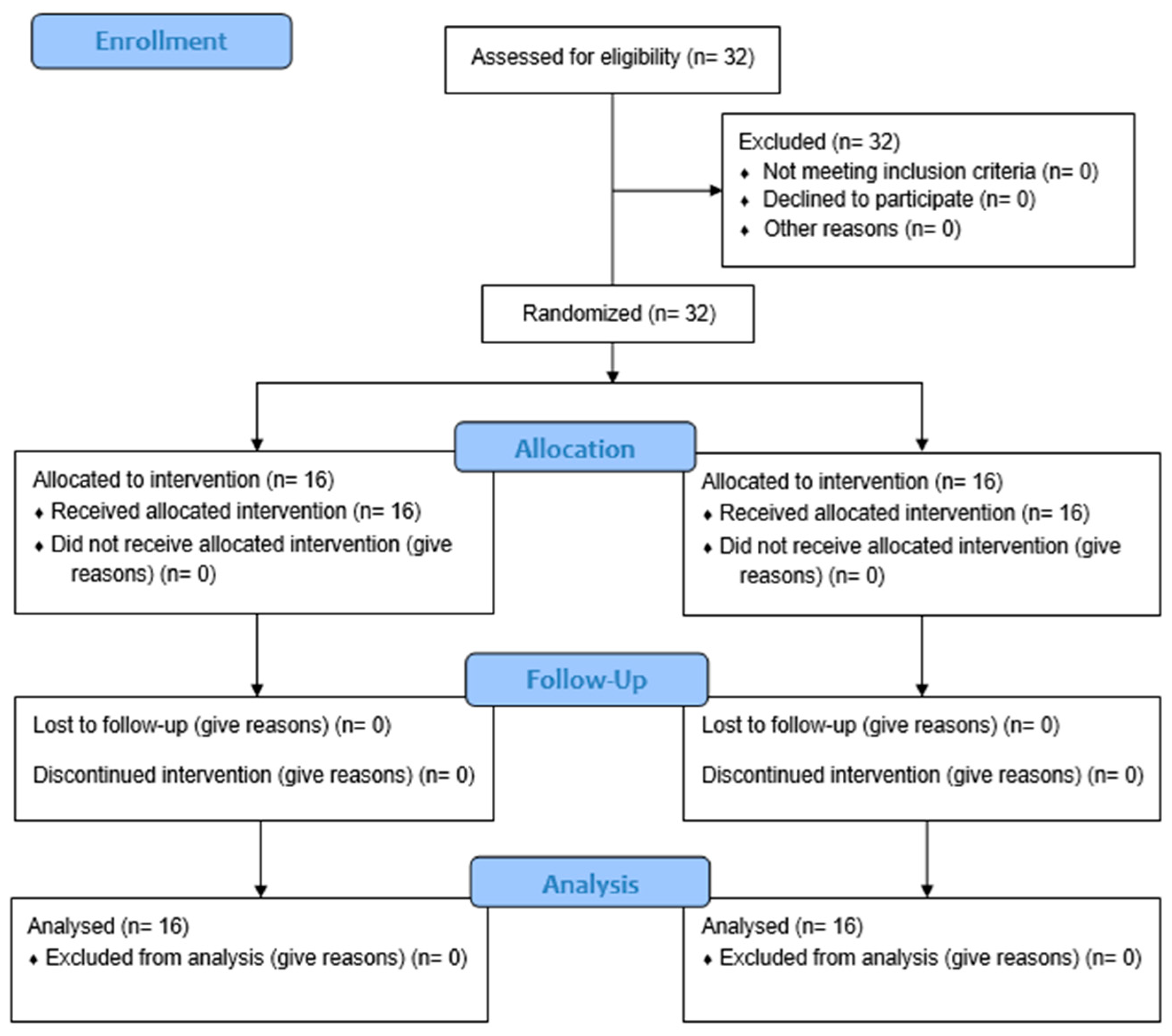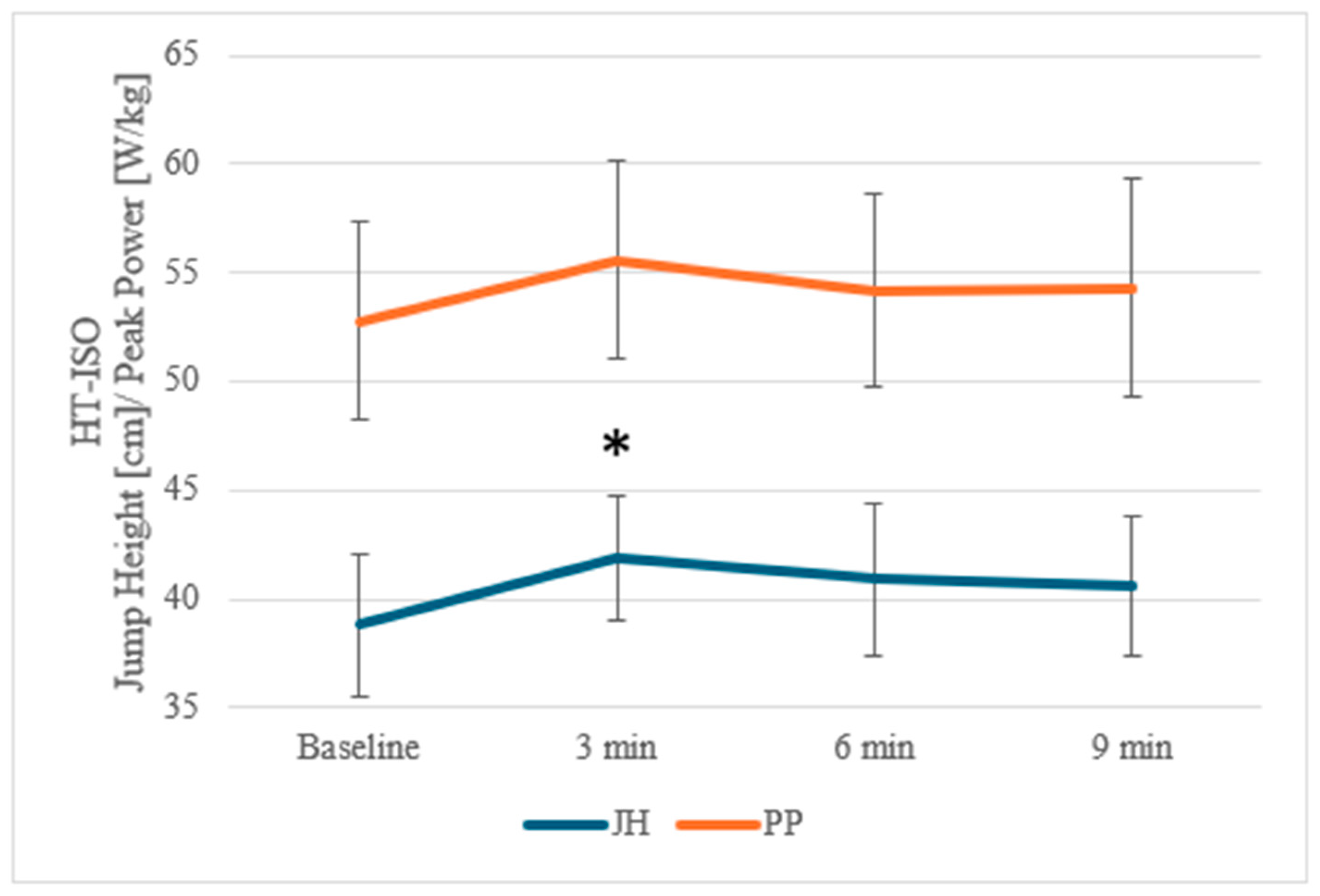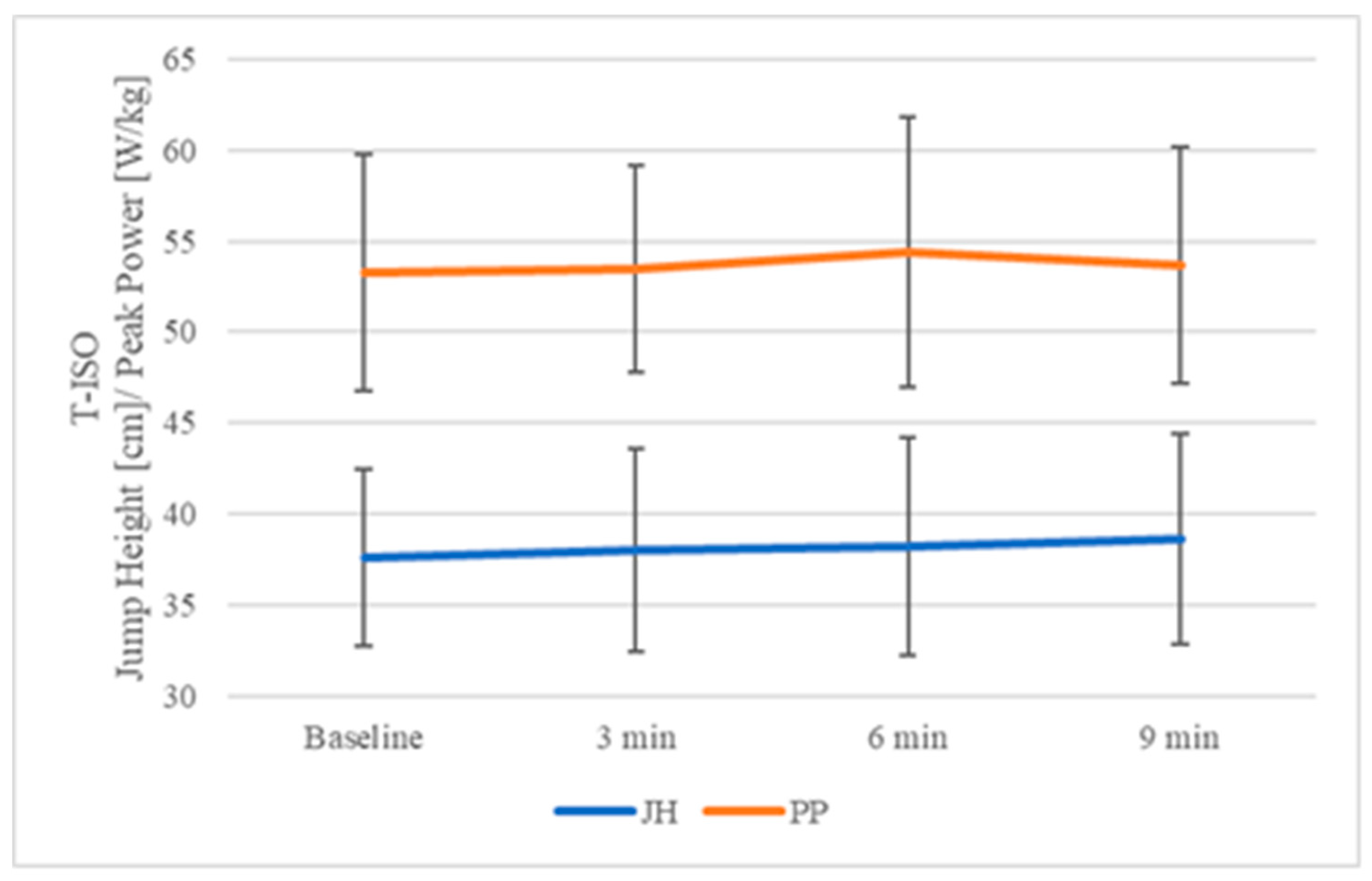Isometric Conditioning Activity and Jump Performance: Impact of Training Status in Male Participants
Abstract
1. Introduction
2. Materials and Methods
2.1. Experimental Approach to the Problem
- CTRL—maintaining light physical activity, where participants were to walk on a treadmill at a speed of 5 km/h for the time equivalent to performing the entire ICA set (9 min).
- ISO—3 sets of ICA, each consisting of 3 repetitions of 3 s maximal isometric contractions, with a total ICA duration of 1 set per 9 s = 27 s, including 3 min rest intervals between sets.
2.2. Participants
- (a)
- Resistance training frequency of ≥3 sessions per week for a minimum of 2 years;
- (b)
- Squat relative 1-repetition maximum (1RM) ≥ 1.2 × body mass;
- (c)
- No history of musculoskeletal injuries resulting in training absence exceeding 4 weeks within 6 months prior to the commencement of the study.
- (a)
- Volleyball training experience of ≥5 years;
- (b)
- Resistance training frequency of ≥3 sessions per week continuously for at least 5 years;
- (c)
- Squat relative 1-repetition maximum (1RM) ≥ 1.4 × body mass;
- (d)
- No musculoskeletal injuries resulting in a training interruption longer than 4 weeks within 6 months preceding the study.
2.3. Procedure
2.4. Measurement of Countermovement Jump Performance
2.5. Statistical Analyses
3. Results
3.1. Jump Height
3.2. Relative Peak Power
3.3. RSI Modified
4. Discussion
5. Conclusions and Practical Implications
Author Contributions
Funding
Institutional Review Board Statement
Informed Consent Statement
Data Availability Statement
Acknowledgments
Conflicts of Interest
Abbreviations
| CA | Conditioning activity |
| ICA | Isometric conditioning activity |
| PAPE | Post-activation performance enhancement |
| CTRL | Control condition |
| ISO | Isometric muscle action condition with total ICA duration of 27 s in 3 sets |
| T | Group consisting of trained participants |
| HT | Group consisting of highly trained participants |
| JH | Jump height |
| PP | Relative peak power output |
| RSImod | Modified reactive strength index |
References
- Blazevich, A.J.; Babault, N. Post-activation potentiation versus post-activation performance enhancement in humans: Historical perspective, underlying mechanisms, and current issues. Front. Physiol. 2019, 10, 1359. [Google Scholar] [CrossRef]
- Seitz, L.B.; Haff, G.G. Factors modulating post-activation potentiation of jump, sprint, throw, and upper-body ballistic performances: A systematic review with meta-analysis. Sports Med. 2016, 46, 231–240. [Google Scholar] [CrossRef] [PubMed]
- Schaefer, L.V.; Bittmann, F.N. Are there two forms of isometric muscle action? Results of the experimental study support a distinction between a holding and a pushing isometric muscle function. BMC Sports Sci. Med. Rehabil. 2017, 9, 11. [Google Scholar] [CrossRef] [PubMed]
- Jarosz, J.; Gawel, D.; Grycmann, P.; Aschenbrenner, P.; Spieszny, M.; Wilk, M.; Krzysztofik, M. How repeatable is PAPE effect: The impact of in-season isometric squat activation on countermovement jump performance enhancement in national level soccer players. BMC Sports Sci. Med. Rehabil. 2025, 17, 115. [Google Scholar] [CrossRef] [PubMed]
- Prieske, O.; Behrens, M.; Chaabene, H.; Granacher, U.; Maffiuletti, N.A. Time to differentiate postactivation “potentiation” from “performance enhancement” in the strength and conditioning community. Sports Med. 2020, 50, 1559–1565. [Google Scholar] [CrossRef] [PubMed]
- Wilson, J.M.; Duncan, N.M.; Marin, P.J.; Brown, L.E.; Loenneke, J.P.; Wilson, S.M.; Jo, E.; Lowery, R.P.; Ugrinowitsch, C. Meta-analysis of postactivation potentiation and power: Effects of conditioning activity, volume, gender, rest periods, and training status. J. Strength Cond. Res. 2013, 27, 854–859. [Google Scholar] [CrossRef]
- Suchomel, T.J.; Lamont, H.S.; Moir, G.L. Understanding vertical jump potentiation: A deterministic model. Sports Med. 2016, 46, 809–828. [Google Scholar] [CrossRef]
- McGowan, C.J.; Pyne, D.B.; Thompson, K.G.; Rattray, B. Warm-up strategies for sport and exercise: Mechanisms and applications. Sports Med. 2015, 45, 1523–1546. [Google Scholar] [CrossRef]
- Jarosz, J.; Gawel, D.; Socha, I.; Ewertowska, P.; Wilk, M.; Lum, D.; Krzysztofik, M. Acute effects of isometric conditioning activity with different set volumes on countermovement jump performance in highly trained male volleyball players. Appl. Sci. 2025, 15, 2393. [Google Scholar] [CrossRef]
- Jarosz, J.; Drozd, M.; Gawel, D.; Wilk, M.; Helbin, J.; Krzysztofik, M. Acute effects of isometric conditioning activity with different distribution contraction on countermovement jump performance in resistance trained participants. Sci. Rep. 2025, 15, 16960. [Google Scholar] [CrossRef]
- Bogdanis, G.C.; Tsoukos, A.; Veligekas, P.; Tsolakis, C.; Terzis, G. Effects of muscle action type with equal impulse of conditioning activity on postactivation potentiation. J. Strength Cond. Res. 2014, 28, 2521–2528. [Google Scholar] [CrossRef]
- Tsoukos, A.; Bogdanis, G.C.; Terzis, G.; Veligekas, P. Acute improvement of vertical jump performance after isometric squats depends on knee angle and vertical jumping ability. J. Strength Cond. Res. 2016, 30, 2250–2257. [Google Scholar] [CrossRef] [PubMed]
- French, D.N.; Kraemer, W.J.; Cooke, C.B. Changes in dynamic exercise performance following a sequence of preconditioning isometric muscle actions. J. Strength Cond. Res. 2003, 17, 678–685. [Google Scholar]
- Vargas-Molina, S.; Salgado-Ramírez, U.; Chulvi-Medrano, I.; Carbone, L.; Maroto-Izquierdo, S.; Benítez-Porres, J.; Cè, E. Comparison of post-activation performance enhancement (PAPE) after isometric and isotonic exercise on vertical jump performance. PLoS ONE 2021, 16, e0260866. [Google Scholar] [CrossRef]
- Spieszny, M.; Trybulski, R.; Biel, P.; Zając, A.; Krzysztofik, M. Post-isometric back squat performance enhancement of squat and countermovement jump. Int. J. Environ. Res. Public Health 2022, 19, 12720. [Google Scholar] [CrossRef]
- Garbisu-Hualde, A.; Gutierrez, L.; Fernández-Peña, E.; Santos-Concejero, J. Intermittent voluntary isometric contractions effects on performance enhancement and sticking region kinematics in the bench press. J. Hum. Kinet. 2023, 87, 105–115. [Google Scholar] [CrossRef]
- Koźlenia, D.; Domaradzki, J. The effectiveness of isometric protocols using an external load or voluntary effort on jump height enhancement in trained females. Sci. Rep. 2023, 13, 13535. [Google Scholar] [CrossRef] [PubMed]
- Koźlenia, D.; Domaradzki, J. Effects of post-activation protocols based on slow tempo bodyweight squat and isometric activity on vertical jump height enhancement in trained males: A randomized controlled trial. PeerJ 2023, 11, e15753. [Google Scholar] [CrossRef] [PubMed]
- Krzysztofik, M.; Spieszny, M.; Trybulski, R.; Wilk, M.; Pisz, A.; Kolinger, D.; Filip-Stachnik, A.; Stastny, P. Acute effects of isometric conditioning activity on the viscoelastic properties of muscles and sprint and jumping performance in handball participants. J. Strength Cond. Res. 2023, 37, 1486–1494. [Google Scholar] [CrossRef]
- Helbin, J.; Latocha, A.; Spieszny, M.; Ewertowska, P.; Wilk, M.; Krzysztofik, M. Acute effects of unilateral conditioning activity on unilateral and bilateral jumping performance and bilateral strength asymmetry. Sci. Rep. 2025, 15, 10552. [Google Scholar] [CrossRef]
- Terbalyan, A.; Mikołajec, K.; Krzysztofik, M.; Urbański, R.; Jarosz, J.; Stastny, P.; Spieszny, M. Effects of overcoming isometric unilateral conditioning activity on subsequent single-leg drop jump in elite and amateur volleyball players: A randomized crossover trial. BMC Sports Sci. Med. Rehabil. 2025, 17, 30. [Google Scholar] [CrossRef]
- Fukutani, A.; Herzog, W. The stretch-shortening cycle effect is prominent in the inhibited force state. J. Biomech. 2021, 115, 110136. [Google Scholar] [CrossRef]
- McKay, A.K.A.; Stellingwerff, T.; Smith, E.S.; Martin, D.T.; Mujika, I.; Goosey-Tolfrey, V.L.; Sheppard, J.; Burke, L.M. Defining training and performance caliber: A participant classification framework. Int. J. Sports Physiol. Perform. 2022, 17, 317–331. [Google Scholar] [CrossRef] [PubMed]
- Xu, K.; Blazevich, A.J.; Boullosa, D.; Ramirez-Campillo, R.; Yin, M.; Zhong, Y.; Tian, Y.; Finlay, M.; Byrne, P.J.; Cuenca-Fernández, F.; et al. Optimizing post-activation performance enhancement in athletic tasks: A systematic review with meta-analysis for prescription variables and research methods. Sports Med. 2025, 55, 977–1008. [Google Scholar] [CrossRef]
- Newham, D.J.; Jones, D.A.; Turner, D.L.; McIntyre, D. The metabolic costs of different types of contractile activity of the human adductor pollicis muscle. J. Physiol. 1995, 488, 815–819. [Google Scholar] [CrossRef]
- McNair, P.J.; Depledge, J.; Brettkelly, M.; Stanley, S.N. Verbal encouragement: Effects on maximum effort voluntary muscle action. Br. J. Sports Med. 1996, 30, 243–245. [Google Scholar] [CrossRef] [PubMed]
- Collings, T.J.; Lima, Y.L.; Dutaillis, B.; Bourne, M.N. Concurrent validity and test–retest reliability of VALD ForceDecks’ strength, balance, and movement assessment tests. J. Sci. Med. Sport. 2024, 27, 572–580. [Google Scholar] [CrossRef] [PubMed]
- Gil, Y.; David, C.H.; Demir, I.; Essawy, B.T.; Fulweiler, R.W.; Goodall, J.L.; Karlstrom, L.; Lee, H.; Mills, H.J.; Oh, J.; et al. Towards the geoscience paper of the future: Best practices for documenting and sharing research from data to software to provenance. Earth Space Sci. 2016, 3, 388–401. [Google Scholar] [CrossRef]
- Cohen, J. Statistical Power Analysis for the Behavioral Sciences, 2nd ed.; Elsevier Science: Burlington, MA, USA, 2013. [Google Scholar]
- Allégue, H.; Turki, O.; Oranchuk, D.J.; Khemiri, A.; Schwesig, R.; Chelly, M.S. The effect of combined isometric and plyometric training versus contrast strength training on physical performance in male junior handball players. Appl. Sci. 2023, 13, 9069. [Google Scholar] [CrossRef]
- Carmichael, D.; Hickey, J.; Tofari, P.; Ward, M.; Timmins, R. Impact of an isometric or eccentric hip extension exercise intervention on hamstring strength, architecture, and morphology. Med. Sci. Sports Exerc. 2022, 25, S48. [Google Scholar] [CrossRef]
- Skurvydas, A.; Jurgelaitiene, G.; Kamandulis, S.; Mickeviciene, D.; Brazaitis, M.; Valanciene, D.; Karanauskiene, D.; Mickevicius, M.; Mamkus, G. What are the best isometric exercises of muscle potentiation? Eur. J. Appl. Physiol. 2019, 119, 1029–1039. [Google Scholar] [CrossRef] [PubMed]
- Lum, D.; Ong, K.Y.; Haischer, M.H. Postactivation performance enhancement with maximal isometric contraction on power-clean performance across multiple sets. Int. J. Sports Physiol. Perform. 2024, 19, 265–270. [Google Scholar] [CrossRef] [PubMed]
- Stotz, A.; Maghames, E.; Mason, J.; Groll, A.; Zech, A. Maximum isometric torque at individually-adjusted joint angles exceeds eccentric and concentric torque in lower extremity joint actions. BMC Sports Sci. Med. Rehabil. 2022, 14, 13. [Google Scholar] [CrossRef]
- Guerra, M.A., Jr.; Caldas, L.C.; Souza, H.L.; Tallis, J.; Duncan, M.J.; Guimarães-Ferreira, L. The effects of physical fitness on postactivation potentiation in professional soccer athletes. J. Strength Cond. Res. 2022, 36, 1643–1647. [Google Scholar] [CrossRef]
- Hodgson, M.; Docherty, D.; Robbins, D. Post-activation potentiation: Underlying physiology and implications for motor performance. Sports Med. 2005, 35, 585–595. [Google Scholar] [CrossRef]
- Doma, K.; Matoso, B.; Protzen, G.; Singh, U.; Boullosa, D. The repeated bout effect of multiarticular exercises on muscle damage markers and physical performances: A systematic review and meta-analyses. J. Strength Cond. Res. 2023, 37, 2504–2515. [Google Scholar] [CrossRef]
- Jarosz, J.; Gaweł, D.; Krzysztofik, M.; Zając, A.; Tsoukos, A.; Bogdanis, G.C.; Wilk, M. Effects of blood flow restriction on mechanical properties of the rectus femoris muscle at rest. Front. Physiol. 2023, 14, 1244376. [Google Scholar] [CrossRef] [PubMed]




| T [n = 16] | HT [n = 16] | |
|---|---|---|
| Age [years] | 22 ± 2 | 27 ± 4 |
| Body mass [kg] | 78 ± 8 | 91 ± 13 |
| Body fat [%] | 10.2 ± 3.4 | 10 ± 2.2 |
| Body height [cm] | 180 ± 5 | 196 ± 8 |
| Resistance training experience [years] | 3.5 ± 1.2 | 9.3 ± 4.2 |
| Relative of 1RM BS [kg/bm] | 1.44 ± 0.2 | 1.49 ± 0.3 |
| Baseline | 3 min | 6 min | 9 min | |||
|---|---|---|---|---|---|---|
| Jump Height [cm] | T | CTRL | 38.9 ± 4.2 | 40.0 ± 4.9 | 39.5 ± 5.8 | 39.1 ± 5.3 |
| ISO | 37.6 ± 4.9 | 38 ± 5.6 | 38.2 ± 6 | 38.6 ± 5.8 | ||
| HT | CTRL | 39.4 ± 2.9 | 38.1 ± 3 | 39.5 ± 2.3 | 38.6 ± 2.5 | |
| ISO | 38.8 ± 3.3 | 41.9 ± 2.9 | 40.9 ± 3.5 | 40.6 ± 3.2 | ||
| Peak Power [W/kg] | T | CTRL | 54.5 ± 6.6 | 54.8 ± 6.7 | 53.9 ± 6.4 | 53.3 ± 6.7 |
| ISO | 53.3 ± 6.5 | 53.5 ± 5.7 | 54.4 ± 7.4 | 53.7 ± 6.5 | ||
| HT | CTRL | 52.5 ± 3.1 | 51.4 ± 3.9 | 52.2 ± 3.8 | 52.0 ± 3.4 | |
| ISO | 52.8 ± 4.6 | 55.6 ± 4.6 | 54.2 ± 4.4 | 54.3 ± 5 | ||
| RSImod | T | CTRL | 0.49 ± 0.10 | 0.51 ± 0.11 | 0.49 ± 0.09 | 0.47 ± 0.09 |
| ISO | 0.47 ± 0.10 | 0.49 ± 0.09 | 0.48 ± 0.10 | 0.50 ± 0.11 | ||
| HT | CTRL | 0.48 ± 0.04 | 0.46 ± 0.04 | 0.49 ± 0.05 | 0.48 ± 0.05 | |
| ISO | 0.51 ± 0.07 | 0.52 ± 0.06 | 0.51 ± 0.07 | 0.51 ± 0.07 |
| Condition | Time | Group | Condition × Time | Condition × Group | Time × Group | Condition × Time × Group | |||
|---|---|---|---|---|---|---|---|---|---|
| Jump Height [cm] | T | CTRL | p = 0.193 | p = 0.009 * | p = 0.262 | p = 0.517 | p = 0.379 | p = 0.511 | p = 0.036 * |
| ISO | |||||||||
| HT | CTRL | ||||||||
| ISO | |||||||||
| Peak Power [W/kg] | T | CTRL | p = 0.264 | p = 0.663 | p = 0.711 | p = 0.333 | p = 0.006 * | p = 0.692 | p = 0.287 |
| ISO | |||||||||
| HT | CTRL | ||||||||
| ISO | |||||||||
| RSImod | T | CTRL | p = 0.277 | p = 0.264 | p = 0.666 | p = 0.593 | p = 0.014 * | p = 0.203 | p = 0.339 |
| ISO | |||||||||
| HT | CTRL | ||||||||
| ISO |
Disclaimer/Publisher’s Note: The statements, opinions and data contained in all publications are solely those of the individual author(s) and contributor(s) and not of MDPI and/or the editor(s). MDPI and/or the editor(s) disclaim responsibility for any injury to people or property resulting from any ideas, methods, instructions or products referred to in the content. |
© 2025 by the authors. Licensee MDPI, Basel, Switzerland. This article is an open access article distributed under the terms and conditions of the Creative Commons Attribution (CC BY) license (https://creativecommons.org/licenses/by/4.0/).
Share and Cite
Jarosz, J.; Szwarc, A. Isometric Conditioning Activity and Jump Performance: Impact of Training Status in Male Participants. J. Clin. Med. 2025, 14, 6214. https://doi.org/10.3390/jcm14176214
Jarosz J, Szwarc A. Isometric Conditioning Activity and Jump Performance: Impact of Training Status in Male Participants. Journal of Clinical Medicine. 2025; 14(17):6214. https://doi.org/10.3390/jcm14176214
Chicago/Turabian StyleJarosz, Jakub, and Andrzej Szwarc. 2025. "Isometric Conditioning Activity and Jump Performance: Impact of Training Status in Male Participants" Journal of Clinical Medicine 14, no. 17: 6214. https://doi.org/10.3390/jcm14176214
APA StyleJarosz, J., & Szwarc, A. (2025). Isometric Conditioning Activity and Jump Performance: Impact of Training Status in Male Participants. Journal of Clinical Medicine, 14(17), 6214. https://doi.org/10.3390/jcm14176214







